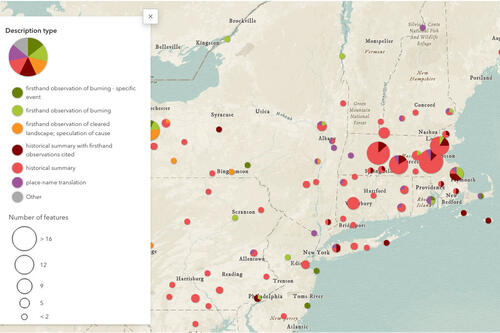
Historical descriptions of Indigenous wildland burning map (Courtesy of Stephen J. Tulowiecki)
Author
Publication
International Journal of Wildland Fire (2024)
Article title
"Compiling Historical Descriptions of Past Indigenous Cultural Burning: a Dataset for the Eastern United States" (Open access)
Summary
Mapping historical descriptions of Indigenous cultural burning in forests and grasslands reveals spatially-extensive use of fire as a land management tool across the northeastern US prior to European-American.
Abstract
Background: The extent of past Indigenous cultural burning in the eastern US remains contested. Historical documents (e.g., early histories, journals, and reports) contain descriptions of burning. Scholars have summarized descriptions, but few have compiled them into databases.
Aims: This paper presents efforts to compile descriptions of past Indigenous burning in the eastern US and early results from mapped descriptions.
Methods: Utilizing previously-cited descriptions and those discovered from digitized historical texts, the current dataset mapped >250 descriptions of burning in the northeastern US. Most were historical summaries from 19th-century authors, and fewer were firsthand observations. Descriptions are currently shared as a GIS data layer, a tabular file, and an interactive web map.
Key results: Descriptions correspond with fire-adapted vegetation, and clusters of descriptions suggest burning over large extents (e.g., southern New England, western New York). Estimated dates of burning or initial Euro-American settlement show an east-west succession in Indigenous fire exclusion and replacement with early Euro-American burning.
Conclusions: Historical descriptions suggest regional-extent influence of Indigenous burning upon past forested ecosystems, but the veracity of descriptions should be carefully evaluated.
Implications: This project provides a dataset for further study of Indigenous burning and comparison with other methodologies for historical cultural fire reconstruction.
Main research questions
- How many historical descriptions (in early explorer/traveler/etc accounts, county histories, etc.) of Indigenous cultural burning exist?
- If you map these accounts, how do they inform our understanding of past cultural burning of forests and grasslands, prior to European-American settlement?
What the research builds on
Historical descriptions of Indigenous cultural burning in forests and grasslands of the eastern US have been utilized to characterize burning, but they have never been mapped, nor extensively searched for and compiled.
What the research adds to the description
Mapping historical descriptions of Indigenous cultural burning in forests and grasslands in the northeastern US suggests that such burning was fairly extensive, and that it correlates with areas of fire-adapted vegetation (e.g. oak, pine, hickory) mapped from other studies. Historical descriptions suggest that fire was an important control on the distribution of tree species.
Novel methodology
Information retrieval methods sought to "read" and discover passages pertaining to Indigenous wildland burning from digitized historical documents (e.g. finding paragraphs with the words "Indians," "burned," "oak," and/or "underbrush").
Implications for future research
Future efforts to compile historical descriptions of Indigenous wildland burning may similarly reveal its spatial extensiveness and its correlation with patterns in fire-adapted vegetation.
Implications for policy
Fire may be more warranted for promoting certain fire-adapted tree species (e.g. white oak) for timber management, since the historical descriptions of Indigenous wildland fire suggest a correlation with such tree species in the past. It may affect how state or federal land management agencies view the role of fire as a component of ecosystems and as a land management tool.
Citation:
Tulowiecki, SJ. "Compiling historical descriptions of past Indigenous cultural burning: a dataset for the eastern United States." International Journal of Wildland Fire 33, WF24029.